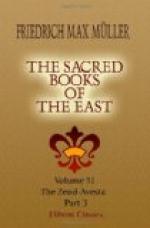Tychsen, in an appendix to his Commentaries, pointed to the importance of the new discovery: “This,” he writes, “is a proof that the Pahlavi was used during the reign of the Sassanides, for it was from them that these inscriptions emanated, as it was by them—nay, by the first of them, Ardeshir Babagan—that the doctrine of Zoroaster was revived. One can now understand why the Zend books were translated into Pahlavi. Here, too, everything agrees, and speaks loudly for their antiquity and genuineness.”
About the same time Sir William Jones, then president of the Royal Asiatic Society, which he had just founded, resumed in a discourse delivered before that society the same question he had solved in such an off-hand manner twenty years before. He was no longer the man to say, “Sied-il a un homme ne dans ce siecle de s’infatuer de fables indiennes?” and although he had still a spite against Anquetil, he spoke of him with more reserve than in 1771. However, his judgment on the “Avesta” itself was not altered on the whole, although, as he himself declared, he had not thought it necessary to study the text. But a glance at the Zend glossary published by Anquetil suggested to him a remark which makes Sir William Jones, in spite of himself, the creator of the comparative grammar of Sanscrit and Zend. “When I perused the Zend glossary,” he writes, “I was inexpressibly surprised to find that six or seven words in ten are pure Sanscrit, and even some of their inflexions formed by the rules of the Vyacaran, as yushmacam, the genitive plural of yushmad. Now M. Anquetil most certainly, and the Persian compiler most probably, had no knowledge of Sanscrit, and could not, therefore, have invented a list of Sanscrit words; it is, therefore, an authentic list of Zend words, which has been preserved in books or by tradition; it follows that the language of the Zend was at least a dialect of the Sanscrit, approaching perhaps as nearly to it as the Pracrit, or other popular idioms, which we know to have been spoken in India two thousand years ago.” This conclusion, that Zend is a Sanscrit dialect, was incorrect, the connection assumed being too close; but it was a great thing that the near relationship of the two languages should have been brought to light.
In 1798 Father Paulo de St. Barthelemy further developed Jones’s remark in an essay on the antiquity of the Zend language. He showed its affinity with the Sanscrit by a list of such Zend and Sanscrit words as were least likely to have been borrowed, viz., those that designate the degrees of relationship, the limbs of the body, and the most general and essential ideas. Another list, intended to show, on a special topic, how closely connected the two languages are, contains eighteen words taken from the liturgic language used in India and Persia. This list was not very happily drawn up, as out of the eighteen instances there is not a single one that stands inquiry; yet




